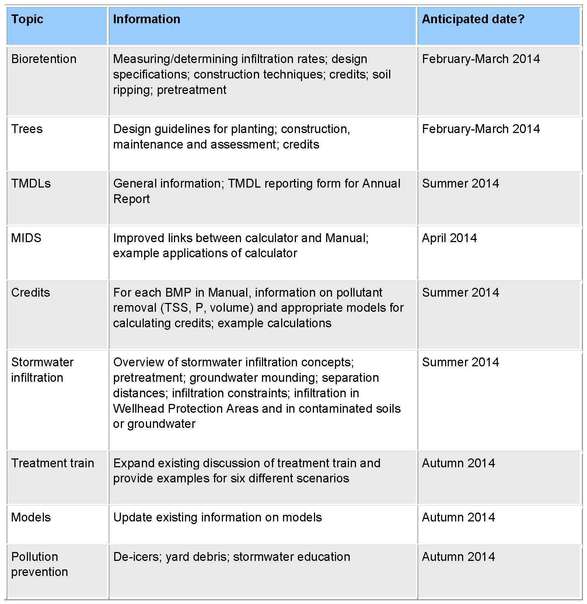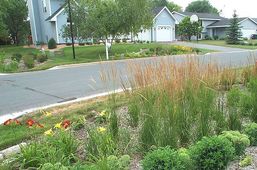|
Welcome to the first edition of the Minnesota Stormwater Manual News. The purpose of this newsletter is to update you on the newest information in the Manual, provide tips on using the Manual, provide interesting stories from the stormwater community, and more. The Minnesota Pollution Control Agency (MPCA), which hosts the online wiki version of the Manual, hopes this newsletter will be a tool for disseminating information and fostering communication within the stormwater community.
The current intent is to publish the newsletter twice a year, but it could go to a quarterly option if warranted and time allows.
The MPCA hopes you find the newsletter useful and informative. Staff in the stormwater program welcome and encourage your feedback.
The MPCA encourages you to promote the use of the Stormwater Manual. Many of you have links to the Stormwater Manual on your website. Please update your links to reflect the new wiki version of the manual: http://stormwater.pca.state.mn.us/index.php/Main_Page.
Users of the Minnesota Stormwater Manual need your help to take full advantage of the wiki technology. The Manual will be an even better resource if you can contribute to one or more of the following areas:
- Case studies and stormwater projects.
- Stormwater related events.
- Links to organization websites.
- Photos and other images. You must own the image and give permission to reproduce it in the Manual. Send us the appropriate acknowledgement with the image.
- Suggestions for technical or general information.
- Links to relevant stormwater research.
You may send information via the Comment box found near the bottom of most web pages in the Manual, or by emailing Mike Trojan or Anne Gelbmann. Please be aware that the MPCA cannot endorse personal products or companies. All information will be reviewed to determine if it is appropriate for the Manual. See the comments and responses in the Manual for examples of how input has already helped improve the Manual.
 The Minnesota Stormwater Manual was originally written in 2005 and underwent revisions in 2008. Due to resource constraints, no updates occurred between 2009 and 2011. Then in 2012, a stakeholder group worked with the MPCA to convert the Manual to a wiki-based format and update it with new technical information, thanks to funding from the Clean Water, Land and Legacy Amendment. Since the official release of the wiki-based Manual on April 2, 2013, there have been more than 800,000 hits on the website. With this powerful wiki technology, the Manual is becoming more diverse, as discussed in articles below.
|
When the wiki version of the Manual was created, the information in the 2008 PDF version of the Manual was simply migrated into the wiki. Since this migration there have been several updates to the technical content of the Manual. These updates, with links to the information, are summarized in the list below.
 Topic: Updated information
-
Permeable pavement: General information; design, construction, maintenance, and performance assessment; credits; references and links.
-
Green roofs: General information; design, construction, maintenance, and performance assessment; cost/benefit; case studies; references and links.
-
Trees: General information; several tables with tree information; soil design guidelines; case studies; street sweeping; references and links.
-
Iron enhanced sand filter (Minnesota Filter): General information; design and maintenance; credits; references and links.
-
Stormwater re-use and rainwater harvesting: General information and guidance; preliminary model results; and references.
-
Turf: Recommended credits and example credit calculations.
-
Bioretention: Media mixes and terminology.
-
Pre-treatment: New section on vegetated filter strips.
|
Although formal stakeholder meetings for the Minimal Impact Design Standards (MIDS) project ended June 30, 2013, the process of incorporating MIDS into the Manual has continued. Here is a summary of the MIDS project and integration of MIDS products into the Manual:
-
The MIDS calculator was released on Feb. 3. The calculator can be accessed through the Manual. The Manual includes the calculator User’s Guide and additional information on the status of the calculator.
-
The Manual includes basic information about MIDS, including an overview and a discussion of performance goals and flexible treatment options.
-
Technical documents produced by consultant that developed the calculator are available in the Manual. Information from these documents has been incorporated into the appropriate sections of the Manual.
The following work should be completed by June 30, 2014:
- Review and update of the existing MIDS information in the Manual.
-
Creation of BMP-specific pages in the Manual that provide an overview on using the MIDS calculator. An example has been created for Bioretention.
- Inclusion of example applications of the MIDS calculator into the Manual.
The MPCA will offer four MIDS and Manual workshops this spring, probably in April. Likely locations for the workshops are Brainerd, Rochester, Duluth, and the Twin Cities. The workshops will be about 4 hours in length and will cover a wide range of information on the Manual and MIDS. Goals for these workshops include soliciting feedback on and recommended updates to the MIDS calculator and the Manual.
The wiki-based platform provides a powerful tool that Manual developers and users are learning as they keep advancing the Manual. Perhaps the main advantage of the wiki is the ability to make changes to the Manual "on the fly." But the wiki itself has many useful capabilities for the user. Discussing these will be a regular feature of this newsletter. This newsletter touches on two features: Categories and Creating a book.
Categories
Looking for a specific photo or an article on design guidelines? A powerful search tool is the use of categories. In the left toolbar on the wiki you will see Categories. Every wiki page can be placed into one or more categories. A category is a way of lumping web pages that have a similar topic or format. So, for example, you can lump all the photos on trees into a single category:
- Click on Categories in the left toolbar and cursor down to Tree photo.
- Click on “Tree photo” and see all the photos of tree Best Management Practices (BMPs).
Take some time to see what’s been placed into categories so far. Developers have just scratched the surface on the number of categories that could be used. Have a suggestion for a category? Send your recommendation to Mike Trojan or Anne Gelbmann, or use the “Help Improve this Page” box at the bottom of each Manual page.
Creating a book
Manual developers understand that many people like to work with printed copies. But they also understand this is the age of computers and mobile devices. The wiki allows you to make a customized book that you can print. Here’s how:
- In the left toolbar, click on Create a book.
- Start the book creator and begin going to pages that you want in your book.
- At the top of the page you'll see the tab called "Book creator." If you want to include the page in your book, add the page to your book. When you are done, show the book.
- You can then title your book, rearrange the order of pages, and export it to a PDF document.
- This tool keeps the last book you created in memory. You cannot save books; you must export it to a PDF if you want to keep a book but also start a new one.
It’s takes some adjustment, but this is a great tool for creating customized documents. Don't forget to disable the book creator when done with it.
In the left toolbar of the Minnesota Stormwater Manual, you'll see several items. Some are new and some are old but newly populated. Be sure to check out these new features:
-
What's New: This page provides a summary of important updates to the Manual. Only significant changes are included, such as incorporation of a new webpage or changes in recommended specifications. MPCA staff recommend checking this site every two to four weeks.
-
Events: This page lists on-going, future and past events related to stormwater. Events include conferences, workshops, training, webcasts, and so on. If you are aware of an event that should be listed on this page, please let MPCA staff know. Be aware that the agency cannot endorse companies or products.
-
Funding: This page provides a summary of funding sources for stormwater projects and a summary of funded stormwater projects. If you are aware of a funded stormwater project that is not listed on this page, please email the appropriate information.
-
Response to comments: There is a comment box on the bottom of most pages in the wiki. MPCA staff try to respond to comments within two weeks. If the information in the response is relevant to a wider audience, staff place the comment and response on the Response to comments page.
-
Future updates: This page provides a summary of anticipated updates to the Manual. Because only broad topic areas are discussed, the page is updated infrequently.
There is so much new material that will be incorporated into the Manual that it is difficult to summarize. The table below lists some of this new information with an estimated date for publishing in the Manual.

 Each Minnesota Stormwater Manual News will include a feature on a specific stormwater topic. This newsletter features bioretention BMPs and phosphorus.
As of 2012 there were 530 lakes in Minnesota impaired for eutrophication, all attributable to excess phosphorus. Urban stormwater can be a major contributor to lake impairments because total phosphorus export from urban land uses is often between 1 and 2 pounds per acre. This compares with typical loading from forested watersheds of 0.2 pounds per acre or less.
One solution to decrease urban phosphorus loading to lakes is to infiltrate stormwater. Bioretention is an important infiltration BMP and includes rain gardens, tree trenches, tree boxes, and other vegetated BMPs. Unfortunately, full infiltration is not feasible in about half of Minnesota due to constraints such as shallow bedrock, presence of karst and shallow depth to water. In these cases a bioretention BMP may include an underdrain that captures stormwater and returns it to the storm sewer system after the runoff has passed through a filter media.
The filter media consists mainly of coarse-textured material such as fine sand, but up to 30 percent or more of the media can consist of organic material. This organic material is rich in phosphorus, with the result that bioretention systems with underdrains can actually contribute to water quality impairments for eutrophication. In fact, the previous manual recommended two mixes (A and B) that were likely to leach phosphorus.
The MPCA contracted with the Kestrel Design Group to identify new mixes and designs that retain rather than leach phosphorus. Two new mixes were added to the Manual (C and D), both of which are recommended when phosphorus retention is a goal for a bioretention BMP with an underdrain. In addition, amendments such as iron and aluminum can be added to bioretention media to sorb phosphorus.
The Manual has been updated to include these two new mixes and a discussion of P-sorbing amendments. This information should be a valuable resource for reducing water quality impacts from urban stormwater.
|
|